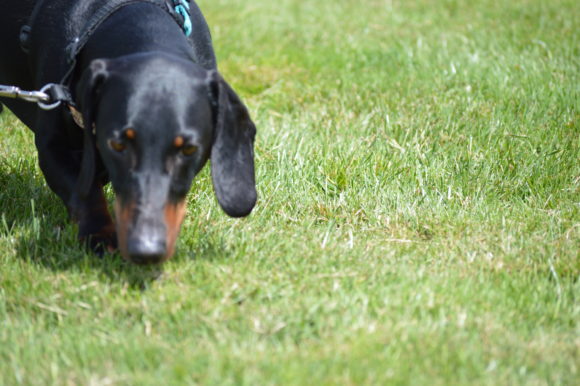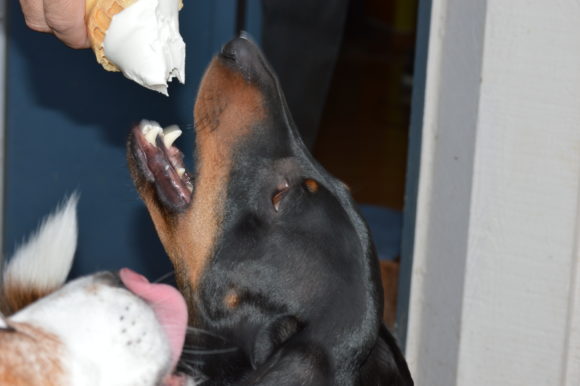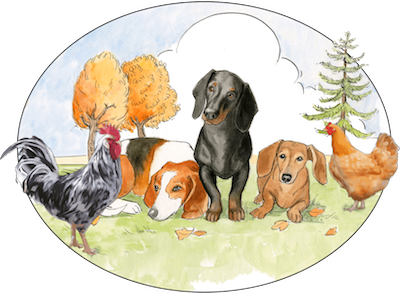Understanding Odor: Interesting Facts About Your Dog’s Nose

As a student of Nosework, I’m fascinated with the subject of how a canine’s nose works. I thought it would be fun to share what I’ve learned from some leading experts. We talk about this all the time during my weekly classes.
The Basics of Odor:
According to Fred Helfers, who started training and handling detection canines in 1982 while working in law enforcement, “Understanding Olfaction and Odors” is multi-faceted. Below are some really interesting facts I wanted to share from a seminar I attended –The Detection Dog.
- Humans have 5 million olfactory sensory cells within their olfactory system
- A large breed canine may have over 200 million sensory cells within their olfactory ststem
- Dogs use “scent discrimination” to detect a specific odor when other odors are present – trained drug detection dogs can determine the drug molecules even when hidden inside a coffee jar. The canine is trained to alert the handler that the narcotic odor is present.
- There are many factors that impact odor molecules: for example, as the air warms an odor source will expand and release more odor molecules. (think about a steak on the grill). Cold environments tend to release little or no odor molecules.
- When there is more moisture – the greater the odor is! I notice this when it has rained and I’m out with the dogs. They go nuts for the scents on their walks and it’s very noticeable that there are more odor molecules then on a hot, dry day.
For any other nosework students – one super helpful tip: Many dogs will be open mouthed sniffing distraction odors but not trained odors!

I cannot imagine what “treats” must smell like!
Additional Resource:
Whole Dog Journal article – canine sense of smell



Stetson loves his nosework classes. I always found it interesting when our instructors talked about how the odors were likely moving around the room based on open doors and air conditioning. Stetson had a more difficult time because he stirred up the odors by running around the room enthusiastically during his searches.
Same – it’s cool to think about the odor cone and how that’s impacting the odor and the wind movement. I love that Stetson loves nosework! It’s fun to watch so many different kinds of dogs work. Thanks!
That’s really interesting, thanks for sharing! My dogs always seem more smell focused when it rains too. Nosework is so fascinating.
Love & biscuits,
Dogs Luv Us and We Luv Them
Thanks! I didn’t notice it until a few years ago – but when it’s damp the dogs are always more “on” it seems and more fired up with noses down! 🙂
My girls always fascinate me with their noses and their ability to find things. We did a tracking seminar on the weekend learning to track on hard surfaces and take turns by buildings as the odor works differently everywhere. They just have amazing noses!
Ditto: I enjoy watching them search for odor and I find it fascinating! It was wet this morning and Shermie went wild following the scent of a cat that was in our yard. That’s really cool you also do tracking – it’s not super popular in the PNW so it’s hard to find classes. I have some friends that do tracking on the East Coast with the doxies… their noses are incredible.
I knew their sense of smell was out of those world but never thought about hot and cold and moisture. Makes sense, the dogs are usually nose to the ground on a warmer day versus say in the winter.
Interesting… That’s for schooling me. 🙂 always down to acquire more knowledge, especially if dog related.
Hi! It’s amazing – in Nosework each week we go through all these odor molecule exercises. We all decide which way the wind is blowing and should the dog start around the corner of a building as a result. It’s very cool. Thank YOU for coming over and reading about nose work! Hope you’re having a good week.
Great info, thank you! The steak example really helped too.
Thank you! I love learning about odor molecules!
This is so interesting. I never thought about the impact of temp and moisture, but of course it makes sense. I mean scents. Woof! Thanks a lot for sharing your knowledge on this!
Scents! Sense! This made me laugh – I’ll be sharing a lot more!! Thank you!
I heard that 60% of their brain activity is generated off their sense of smell. Do you if there is any truth to that?
No but I’d absolutely love to find out if that’s the case – that’s amazing!! Let me ask my nosework instructor this Tuesday — on it.